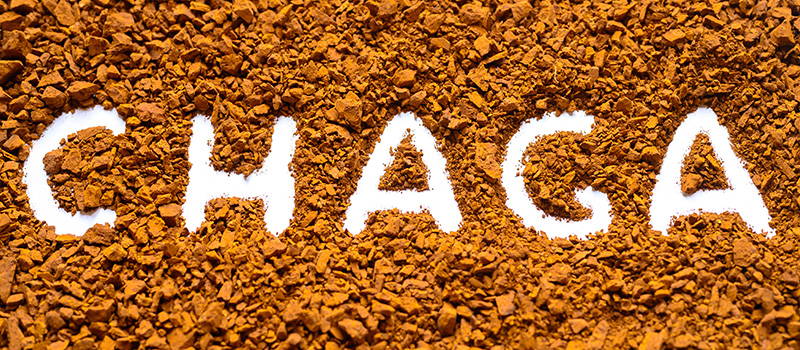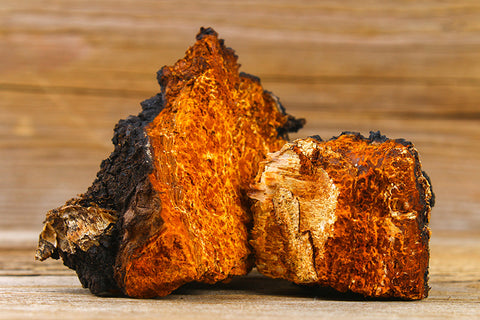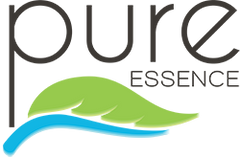The Chaga Story: A Fungus with Amazing Benefits

Mushrooms are a delectable addition to many meals. They have been used for millennia in both culinary practices and eastern traditional medicine, but only recently have mushrooms been truly considered a powerful and reliable supplement to our health.
There are several mushrooms that offer numerous health benefits, but today we want to talk about a mushroom that doesn’t look like your typical mushroom. In fact, it’s technically not a mushroom.
Native to the cool, wintery climates of Siberia, Canada, and Northern Europe. “Friend” to birch trees. And known for its coal-like exterior, let us present – the chaga mushroom.

Not a mushroom? Then what is it?
Scientifically known as Inonotus obliquus, chaga was adopted as the common name for the mushroom, stemming from its Russian name, чага. But it also has several nicknames, like “Cinder Conk,” “Clinker Polypore,” and “Black Mass,” attributed to the black, barky appearance of chaga. And sometimes it’s called “Black Gold” for its golden-orange interior.
But chaga isn’t all fun and names – it has its own interesting story. We know chaga grows on birch trees and other hardwood, like several mushrooms. But chaga doesn’t just grow on them – its spores enter wounded spots in the tree and infect it with heart rot. As the tree stays alive, chaga can repeatedly form its band-aid-like covering over the wounded part of the tree. You can harvest the chaga conk and it will regrow until it has sapped the tree of its nutrients. Once the tree is dead from the infection, it may split open to reveal the fruiting body of the chaga which may then spread more spores.
So why is chaga not a mushroom? While chaga is a fungus, it is not technically a mushroom. Mushrooms are considered to be fruiting body fungi.
But we just said chaga had a fruiting body, right?
It’s kind of complicated.
The chaga that is harvested and used and seen is not a fruiting body, it is simply a mass of mycelium and bark. But oh, what a beautiful antioxidant-filled mass of mycelium it is.

The Antioxidant King
Chaga is known to have been used as far back as the 6th century by the Khanty people in Russia. They used chaga mushrooms to help digestion and detoxification, and to soothe skin sores. But there is also record of its use in first century B.C.E. writings by Chinese herbalist, Shen Nong.[1] Traditional Chinese Medicine used chaga to preserve youthfulness, promote health, and encourage longevity.
One of the reasons chaga is so beneficial is its antioxidant content. Chaga mushrooms have one of the highest antioxidant contents of any other food. They have an Oxygen Radical Absorbance Capacity (ORAC) value of 146,700 μ mol TE/100g. “By comparison, the açai berry has a lower score at 102,700 μ mol TE/100g.”[2] The ORAC value is a method used by the National Institutes of Health to measure the antioxidant capacity of foods. Don’t worry if you don’t understand the numbers, in layman terms it means chaga has a boatload of antioxidants!
Antioxidants help neutralize free radicals that cause damage to the body. A study in the International Journal of Biological Macromolecules, shows that a chaga polysaccharide has “strong antioxidant activity for scavenging free radicals.”[3] That means that chaga mushrooms contain strong free radical scavengers that seek out free radicals and neutralize them by giving them an electron, thus preventing more damage.
The antioxidant properties of chaga counteract oxidative stress and can help lower blood pressure, reduce LDL (the bad cholesterol), promote longevity, and repair skin. What makes chaga a potent antioxidant? It contains the triterpene antioxidant known as betulin, which is a compound that chaga absorbs from the birch tree it infected.

And It Has Several Benefits
When it comes to chaga mushrooms, the benefits don’t stop with antioxidants. Chaga is a wonderful immune system booster! Like most mushrooms, chaga contains beta-glucans and polysaccharides. These can increase your immune defense system by enhancing macrophages and cell function. Chaga also promotes the formation of good cytokines, which regulates immune response and stimulates white blood cells (the first line of defense for your immune system)[4].
Your body also has bad cytokines, which trigger the inflammation response of your immune defense.[5] Inflammation has been linked to chronic diseases like rheumatoid arthritis and depression. Research has shown that chaga mushrooms can modulate the production of the bad cytokines, thus making it an effective anti-inflammatory agent.
And remember the antioxidant betulin? Betulin has been shown to have anti-cancer properties.[6] Multiple studies show chaga mushrooms have strong anti-cancer properties, especially when it comes to slowing the growth of certain types of cancers like lung, breast, and cervical.[7],[8] And triterpenes found in chaga can cause tumor cells to self-destruct, while not having an effect on healthy cells. More studies on chaga’s anti-cancer properties are still needed – but so far, they have yielded promising results.
Lastly, the chaga mushroom is FULL of vitamins, minerals, and nutrients! Like most mushrooms, chaga has vitamin D, iron, magnesium, potassium, manganese, and calcium. And it is also high in B complex vitamins, selenium, and copper.

You Should Probably Add It To Your Diet
Despite its bitter and earthy taste, chaga is traditionally enjoyed in a hot cup of tea. The hot water helps breakdown the chaga molecules and allows them to be easily absorbed in the intestines. Fun fact: during World War 2 there was a coffee shortage in Finland.[9] One of the favorited substitutes that popped up was the chaga coffee, Tikka Te.
However, if tea is not your thing or you’d like a more convenient method of taking chaga, you can also get it in supplement form in our MyPure™ MYcoMune™ and MyPure™ MYcoMune™ 4x, where it is combined with other powerhouse mushrooms – Reishi, Cordyceps, Lion’s Mane, Maitake, and Shiitake – for ultimate immune boosting and maximum performance.*
Sources
[1] https://www.whiterabbitinstituteofhealing.com/herbs/chaga/
[2] https://www.naturealmco.com/blogs/news/is-chaga-mushroom-an-antioxidant-whats-chagas-orac
[3] Hu, Yang et al. “Antioxidant activity of Inonotus obliquus polysaccharide and its amelioration for chronic pancreatitis in mice.” International journal of biological macromolecules vol. 87 (2016): 348-56. doi:10.1016/j.ijbiomac.2016.03.006
[4] Ko, Suk-kyung et al. “Inonotus obliquus extracts suppress antigen-specific IgE production through the modulation of Th1/Th2 cytokines in ovalbumin-sensitized mice.” Journal of ethnopharmacology vol. 137,3 (2011): 1077-82. doi:10.1016/j.jep.2011.07.024
[5] Ramani, Thulasi et al. “Cytokines: The Good, the Bad, and the Deadly.” International journal of toxicology vol. 34,4 (2015): 355-65. doi:10.1177/1091581815584918
[6] Rzeski, Wojciech et al. “Betulin elicits anti-cancer effects in tumour primary cultures and cell lines in vitro.” Basic & clinical pharmacology & toxicology vol. 105,6 (2009): 425-32. doi:10.1111/j.1742-7843.2009.00471.x
[7] Lee, Sung Hak et al. “Antitumor activity of water extract of a mushroom, Inonotus obliquus, against HT-29 human colon cancer cells.” Phytotherapy research : PTR vol. 23,12 (2009): 1784-9. doi:10.1002/ptr.2836
[8] Chung, M. J., Chung, C.-K., Jeong, Y., & Ham, S.-S. (2010, June 29). Anticancer activity of subfractions containing pure compounds of chaga mushroom (Inonotus obliquus) extract in human cancer cells and in Balbc/c mice bearing sarcoma-180 cells. Nutrition Research and Practice, 4(3), 177-182
https://synapse.koreamed.org/search.php?where=aview&id=10.4162/nrp.2010.4.3.177&code=0161NRP&vmode=FULL
[9] Westberg, Norman. “Soldier Boy” To the Bomb and Back: Finnish War Children Tell Their World War II Stories, edited by Sue Saffle, Berghahn Books, 2015, p. 302.
